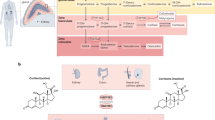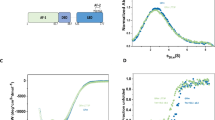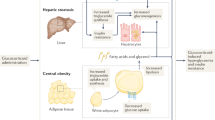Abstract
GLUCOCORTICOID hormones exert many of their effects by modifying the activity of certain enzymes in target tissues, probably as a result of alterations in gene expression1. Experimental models have been developed in which enzyme induction by various steroids correlates well with their anti-inflammatory, thymolytic and glycopexic properties. This is the case for tyrosine transaminase in cultured rat hepatoma (HTC) cells2,3. Studies in this system showed that, in addition to glucocorticoid agonists, partial agonists and antagonists could be identified4. The latter compete with agonists for binding to the intracellular glucocorticoid receptor but do not trigger the glucocorticoid effect5. Compounds which specifically antagonise glucocorticoid action at the target cell would be useful for the treatment of certain diseases characterised by excessive production of gluco-corticoids1 and for further studying the molecular mechanism of action of these hormones. However, unlike anti-androgens and anti-oestrogens6, the only known glucocorticoid anatagonists are natural steroid hormones (such as progesterone and testosterone) or their analogues, which interact with their own receptors and plasma binding proteins and are therefore not very specific. We report here that new derivatives of dexamethasone, a specific glucocorticoid agonist which does not bind to rat or human plasma transcortin5, can block the induction of tyrosine transaminase in HTC cells.
Similar content being viewed by others
Article PDF
References
Baxter, J. D. Pharmac. Ther. B 2, 605–659 (1976).
Thompson, E. B., Tomkins, G. M. & Curran, J. F. Proc. natn. Acad. Sci. U.S.A. 56, 296–303 (1966).
Rousseau, G. G. J. Steroid Biochem. 6, 75–89 (1975).
Samuels, H. H. & Tomkins, G. M. J. molec. Biol. 52, 57–74 (1970).
Rousseau, G. G., Baxter, J. D. & Tomkins, G. M. J. molec. Biol. 67, 99–115 (1972).
Raynaud, J. P. et al. J. Steroid Biochem. 6, 615–622 (1975).
Rousseau, G. G. & Schmit, J. P. J. Steroid Biochem. 8, 911–919 (1977).
Schmit, J. P. & Rousseau, G. G. J. Steroid Biochem. 9, 909–920 (1978).
Author information
Authors and Affiliations
Rights and permissions
About this article
Cite this article
ROUSSEAU, G., KIRCHHOFF, J., FORMSTECHER, P. et al. 17β- Carboxamide steroids are a new class of glucocorticoid antagonists. Nature 279, 158–160 (1979). https://doi.org/10.1038/279158a0
Received:
Accepted:
Published:
Issue date:
DOI: https://doi.org/10.1038/279158a0
This article is cited by
-
A high-throughput assay for assessing the cell permeability of combinatorial libraries
Nature Biotechnology (2005)
-
Corticosteroid receptor antagonists: A current perspective
Pharmacy World & Science (1995)



